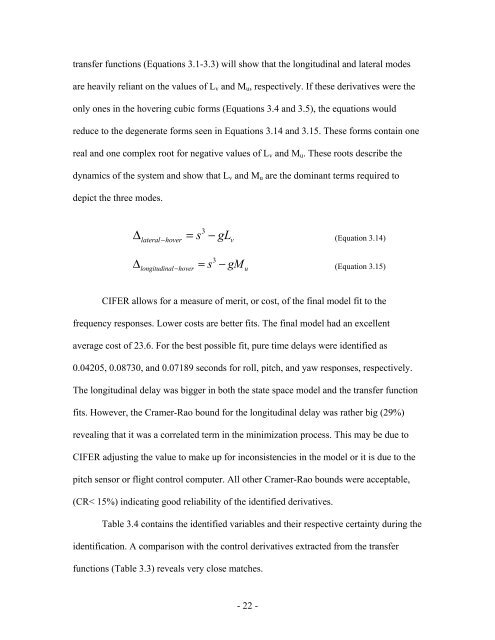Comprehensive System Identification of Ducted Fan UAVs - Cal Poly
Comprehensive System Identification of Ducted Fan UAVs - Cal Poly
Comprehensive System Identification of Ducted Fan UAVs - Cal Poly
Create successful ePaper yourself
Turn your PDF publications into a flip-book with our unique Google optimized e-Paper software.
transfer functions (Equations 3.1-3.3) will show that the longitudinal and lateral modesare heavily reliant on the values <strong>of</strong> L v and M u , respectively. If these derivatives were theonly ones in the hovering cubic forms (Equations 3.4 and 3.5), the equations wouldreduce to the degenerate forms seen in Equations 3.14 and 3.15. These forms contain onereal and one complex root for negative values <strong>of</strong> L v and M u . These roots describe thedynamics <strong>of</strong> the system and show that L v and M u are the dominant terms required todepict the three modes.3∆lateral −hover= s − gLv(Equation 3.14)3∆longitudinal−hover= s − gMu(Equation 3.15)CIFER allows for a measure <strong>of</strong> merit, or cost, <strong>of</strong> the final model fit to thefrequency responses. Lower costs are better fits. The final model had an excellentaverage cost <strong>of</strong> 23.6. For the best possible fit, pure time delays were identified as0.04205, 0.08730, and 0.07189 seconds for roll, pitch, and yaw responses, respectively.The longitudinal delay was bigger in both the state space model and the transfer functionfits. However, the Cramer-Rao bound for the longitudinal delay was rather big (29%)revealing that it was a correlated term in the minimization process. This may be due toCIFER adjusting the value to make up for inconsistencies in the model or it is due to thepitch sensor or flight control computer. All other Cramer-Rao bounds were acceptable,(CR< 15%) indicating good reliability <strong>of</strong> the identified derivatives.Table 3.4 contains the identified variables and their respective certainty during theidentification. A comparison with the control derivatives extracted from the transferfunctions (Table 3.3) reveals very close matches.- 22 -













